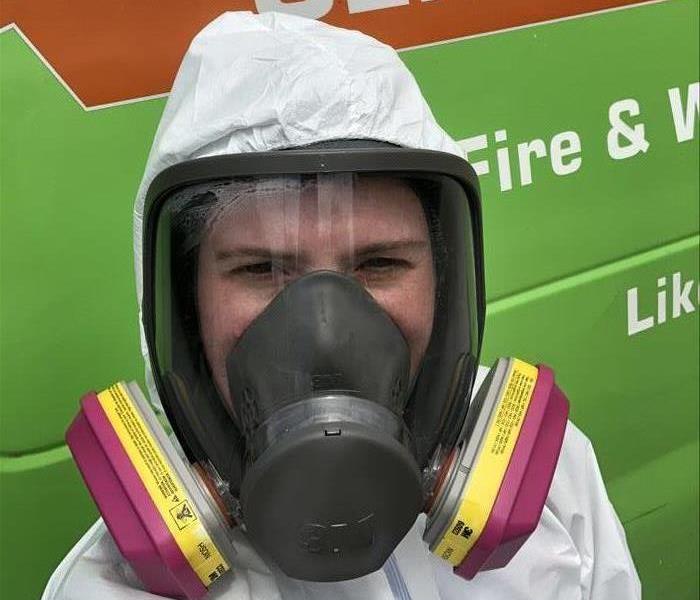Blog 2: Protecting You and Our Employees With Proper PPE and Training
5/18/2020 (Permalink)
 Our team is trained and prepared in safety and protective equipment to help keep YOU, our customers, and US safe.
Our team is trained and prepared in safety and protective equipment to help keep YOU, our customers, and US safe.
Worker Safety Training
SERVPRO of Mandarin takes great responsibility to help ensure employees entering and working in areas contaminated with biological or infectious matter or in designated areas where contaminated contents are being handled and decontaminated have received proper training and personal protective equipment (PPE).
Our safety training includes hazard communication, proper PPE selection, proper donning and doffing procedures, proper personal hygiene, and incident reporting.
• Hazard communication: Inform workers of hazards related to the work being performed, chemicals they will be using, and the importance of PPE usage.
• Proper PPE selection: Inform workers that personal protective equipment is required within the work area. Inform workers that they will be wearing respiratory protection, disposable coveralls, eye protection, and hand protection. Inform workers that coveralls and gloves are disposable and should be changed prior to re-entering the work area. Inform workers on the cleaning and decontamination process required for any reusable PPE.
• Proper donning and doffing procedures - Inform workers that personal protective equipment must be put on and taken off following a specific procedure.
• Proper personal hygiene – Inform workers that specific hygiene practices must be followed.
• Sign In/Out: Inform workers they will be required to sign in and sign out of the work area.
• Incident reporting – Inform workers that any exposure to infectious materials (skin, eye, mouth, mucous membrane) must be reported to the supervisor immediately. If contact with blood or Other Potential Infectious Material (OPIM) occurs, skin must be washed with soap and water or eyes, and mucous membranes flushed with water immediately.
Personal Protective Equipment (PPE)
Personal protective equipment (PPE) should be selected and used to maintain worker health and safety.
• Respirators: Due to potential respiratory exposure, at a minimum, an N-95 respirator should be worn by all workers. Tight-fitted respirators may also be worn including half-mask respirators or full-face respirators; with P100 filters.xi This includes air-purifying respirators (APR) and powered air-purifying respirators
(PAPR). An APR or PAPR is recommended for Enhanced Cleanup.
• Coveralls: Coveralls with attached hood and boots should be worn by all workers. For added protection, other options such as disposable non-permeable coveralls with a separate boot cover or disposable non-permeable coveralls with built-in booties may be considered. All coveralls should have a storm flap over the front zipper. The appropriate size is typically coat size or coat size plus one. Recommend XL and XXL sizes.
• Gloves: Disposable gloves, 4-mil nitrile should be used for outer glove and a 5-mil nitrile long-cuff glove for the inner glove. Two different color gloves, one for inner and one for outer, would allow for tears to be noticeable; this is recommended but not required.
• Tape: Tape should be used to seal gloves to coveralls.
• Face Shield or Goggles: If using an N-95 or half-mask respirator, eye protection should include a face shield or goggles.
A designated area will be established for donning and doffing PPE outside the work area. All donning and doffing will take place in this designated area. This area will have to be cleaned, disinfected, and maintained. Donning procedures will be established and adhered to throughout the cleaning and disinfecting process. Cleanup personnel will don PPE prior to entering the work area and engaging in cleaning and disinfecting surfaces, and/or manipulating contents. Donning procedures will be observed by trained personnel. During the cleaning and disinfecting process, cleanup personnel will keep their PPE on while working in the space. Cleanup personnel will avoid touching any exposed skin while working to limit dermal exposure. Doffing procedures will be established and adhered to throughout the cleaning and disinfecting process. When removing PPE and other soiled materials, we will not allow the outer surfaces of PPE and other soiled materials to contact bare skin. Doffing procedures will be observed by trained personnel. Personal hygiene best practices will be observed after exiting the workspace.






 24/7 Emergency Service
24/7 Emergency Service